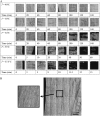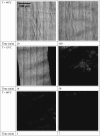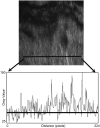Investigating mechanisms of collagen thermal denaturation by high resolution second-harmonic generation imaging
- PMID: 16829565
- PMCID: PMC1562377
- DOI: 10.1529/biophysj.106.085902
Investigating mechanisms of collagen thermal denaturation by high resolution second-harmonic generation imaging
Abstract
We apply the technique of second-harmonic generation (SHG) microscopy to obtain large area submicron resolution image of Type I collagen from rat tail tendon as it is heated from 40 degrees C to 70 degrees C for 0-180 min. The change in the collagen structure as reflected in its SHG image is observed at length scales from submicron to hundreds of microns. We observed that heating the tendon below the temperature of 54 degrees C does not produce any change in the averaged SHG intensity. At the heating temperature of 54 degrees C and above, we find that increasing the heating temperature and time leads to decreasing SHG intensity. As the tendon is heated above 54 degrees C, the regions where the SHG signal vanish and form a tiger-tail like pattern. In addition, a decrease in the SHG signal occurs uniformly throughout the tendon. By comparing the relative SHG intensities in small and large areas, we found that the denaturation process responsible for forming the tiger-tail like pattern occurs at a higher rate than the global denaturation process occurring throughout the tendon. We also measured the fibril spacing and found that it remains constant at 1.61 +/- 0.04 micron for all heating temperature and times. The constant fibril density shows that the global denaturation process occurs at a length scale smaller than the size of the fibril. Our results show that second-harmonic generation microscopy is effective in monitoring the thermal damage to collagen and has potential applications in biomedicine.
Figures







Similar articles
-
Prediction of heat-induced collagen shrinkage by use of second harmonic generation microscopy.J Biomed Opt. 2006 May-Jun;11(3):34020. doi: 10.1117/1.2209959. J Biomed Opt. 2006. PMID: 16822069
-
Monitoring the thermally induced structural transitions of collagen by use of second-harmonic generation microscopy.Opt Lett. 2005 Mar 15;30(6):622-4. doi: 10.1364/ol.30.000622. Opt Lett. 2005. PMID: 15791996
-
Second harmonic generation confocal microscopy of collagen type I from rat tendon cryosections.Biophys J. 2006 Dec 15;91(12):4665-77. doi: 10.1529/biophysj.106.093740. Biophys J. 2006. PMID: 17130233 Free PMC article.
-
Second-harmonic generation imaging of cancer.Methods Cell Biol. 2014;123:531-46. doi: 10.1016/B978-0-12-420138-5.00028-8. Methods Cell Biol. 2014. PMID: 24974046 Review.
-
From molecular structure to tissue architecture: collagen organization probed by SHG microscopy.J Biophotonics. 2013 Feb;6(2):129-42. doi: 10.1002/jbio.201200092. Epub 2012 Jul 12. J Biophotonics. 2013. PMID: 22791562 Review.
Cited by
-
Effect of Heat Level and Expose Time on Denaturation of Collagen Tissues.Cell Mol Bioeng. 2020 Sep 28;14(1):113-119. doi: 10.1007/s12195-020-00653-w. eCollection 2021 Feb. Cell Mol Bioeng. 2020. PMID: 33643470 Free PMC article.
-
Collagen denaturation is initiated upon tissue yield in both positional and energy-storing tendons.Acta Biomater. 2020 Dec;118:153-160. doi: 10.1016/j.actbio.2020.09.056. Epub 2020 Oct 6. Acta Biomater. 2020. PMID: 33035697 Free PMC article.
-
The Texture Change of Chinese Traditional Pig Trotter with Soy Sauce during Stewing Processing: Based on a Thermal Degradation Model of Collagen Fibers.Foods. 2022 Jun 16;11(12):1772. doi: 10.3390/foods11121772. Foods. 2022. PMID: 35741970 Free PMC article.
-
Screening of protein crystallization trials by second order nonlinear optical imaging of chiral crystals (SONICC).Methods. 2011 Dec;55(4):379-86. doi: 10.1016/j.ymeth.2011.11.003. Epub 2011 Nov 17. Methods. 2011. PMID: 22101350 Free PMC article. Review.
-
Tissue effects of intra-tissue refractive index shaping (IRIS): insights from two-photon autofluorescence and second harmonic generation microscopy.Biomed Opt Express. 2019 Jan 24;10(2):855-867. doi: 10.1364/BOE.10.000855. eCollection 2019 Feb 1. Biomed Opt Express. 2019. PMID: 30800519 Free PMC article.
References
-
- Wright, N. T., and J. D. Humphrey. 2002. Denaturation of collagen via heating: an irreversible rate process. Annu. Rev. Biomed. Eng. 4:109–128. - PubMed
-
- Lyons, T. R., P. L. Griffith, F. H. Savoie, and L. D. Field. 2001. Laser-assisted capsulorrhaphy for multidirectional instability of the shoulder. Arthroscopy. 17:25–30. - PubMed
-
- McDonald, M. B., P. S. Hersh, E. E. Manche, R. K. Maloney, J. Davidorf, and M. Sabry. The Conductive Keratoplasty United States Investigators Group. 2002. Conductive keratoplasty for the correction of low to moderate hyperopia: U.S. clinical trial 1-year results on 355 eyes. Ophthalmology. 109:1978–1989. - PubMed
-
- Fitzpatrick, R. E., M. P. Goldman, N. M. Satur, and W. D. Tope. 1996. Pulsed carbon dioxide laser resurfacing of photoaged facial skin. Arch. Dermatol. 132:395–402. - PubMed
Publication types
MeSH terms
Substances
LinkOut - more resources
Full Text Sources
Other Literature Sources
Research Materials

